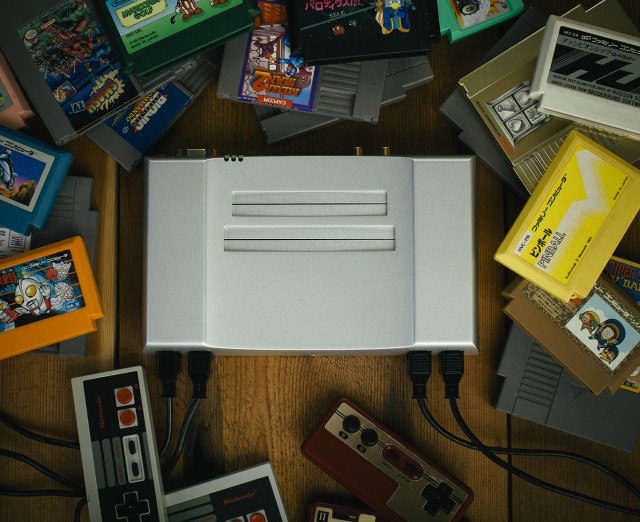
People who are serious about audio tend to be serious about their audio equipment. Audiophiles can easily spend hundreds or thousands of dollars on precisely tuned and protected record players, cables, amplifiers, receivers, and speakers to make sure the sound of those classic vinyl LPs comes out sounding just right.
Diehard retro game fans have fewer serious options for getting an authentic yet high-end experience out of their old cartridges. Original consoles can run into problems with everything from the power supply to the cartridge connector pins as they age, and they don't have modern audio and video outputs for today's home theaters. The "Famiclones" and other copycat hardware out there are usually based on imitation chips that can have serious issues with compatibility and authenticity to the real hardware's output. Emulation-based solutions can offer a wide degree of customization and flexibility, but they also come with their own problems with compatibility and authenticity (unless you go to somewhat extreme lengths).
Christopher Taber didn't want to settle for these kinds of compromises in building his own updated version of the classic NES/Famicom. To that end, he's created what appears to be the most ambitious mass market retro console modification the world has yet seen. The Analogue Nt, which starts taking pre-orders today, is an aluminum-encased love letter to the original Nintendo hardware, with authentic processors from the original hardware driving modern, high-end output and design features. The system was designed and produced with what Taber tells Ars is the "same philosophy of designing a piece of hi-fi equipment" out of "a desire to explore this massive, beautiful part of video game history properly."
Oh, and did we mention the system starts at $500? No one said quality comes cheap.
Authentic guts in a modern package

Taber says he was inspired to create "a product with an unbelievable degree of quality" to fill a market niche that, to this point, hasn't really existed (outside of Analogue's own Walnut Neo Geo, that is). "As far as I know, other than maybe one-off unique items, there aren't any high-end commercial products in video games. I mean, it's not that there aren't quality products, but for example, a Leica of video games? That doesn't exist. I want every single product that we produce to be designed and built at a remarkable quality. I don't think I'm interested in anything else."
Unlike the cheap Famiclones that have flooded the market in recent years, Taber says the guts of the Analogue Nt are based on the actual CPU and PPU chips found in the original Famicom. (A total of 60 million or so systems were produced, but fewer are sitting unloved in second-hand shops all over the world.) "We were able to procure a large quantity of HVC-001 Famicom systems that were in cosmetically undesirable/unsellable condition," he told Ars. "The plastic enclosures of the HVC-001 systems are notoriously yellowed, brittle, and damaged. While the poor enclosure quality left these systems undesirable and sitting on a shelf, fortunately the CPU and PPU inside remain untouched and fully functional.... In other words: no emulation."
Aside from those core chips, which ensure perfect compatibility with the entirety of the NES and Famicom libraries, Taber says the system has been designed from the ground up to provide all sorts of modern, aftermarket upgrades to the retro gaming experience. That means composite, component, and S-Video outputs, with an optional $50 HDMI adapter for high-def systems (with optional scanline support). It also means brand new cartridge slots supporting both NES and Famicom cartridges, as well as expansions like the Famicom Disk System (and its expanded audio capabilities). It means four brand new off-the-shelf controller ports built in for games that would usually require an adapter, and a color palette switch that lets you change to modern colors or the improved "PlayChoice 10" arcade colors. It means amplified, shielded, split-channel stereophonic sound to improve the mono signal coming out of the hardware ("Seriously, it sounds so good... teary-eyed, blissfully good," Taber enthused).That also means, most conspicuously, the casing. It's made from "a single, solid block of 6061 aluminum," created by designer Ernest Dorazio, manufactured in China, and assembled in the US. Taber doesn't claim this high-end housing improves the actual signal quality or gameplay experience at all (unlike some high-end audio knob manufacturers), but he says the high-end enclosure reflects a general focus on quality craftsmanship over price-consciousness.
"Yes, aluminum is more expensive than plastic—but that isn't the only reason it is at this [$500] price point," he said. "The components and general fine production details are what quickly adds up. The question is usually what compromises you want to make. We don't want to make any compromises. It's not at this price point solely because of an aluminum enclosure, it's at this price point because the quality of everything inside and out is integrated. I love the quote from Benjamin Franklin, 'The bitterness of poor quality remains long after the sweetness of low price is forgotten.'"
It's hard to imagine that there will be a huge market for a 30-year-old console that costs more than a brand new PlayStation 4 with a game included. Still, for the retro gaming equivalent of the big-spending, quality-obsessed audiophile, $500 for a top-notch product that will last might be a good value. We know we can't wait to get our hands on one for some in-person testing.
"I admire the philosophy 'buy less, but more quality,'" Taber said. "I'd rather save up and buy something that's really nice, that's gonna last for virtually my entire life. Something to cherish forever. The Analogue Nt was developed in this light."
reader comments
198